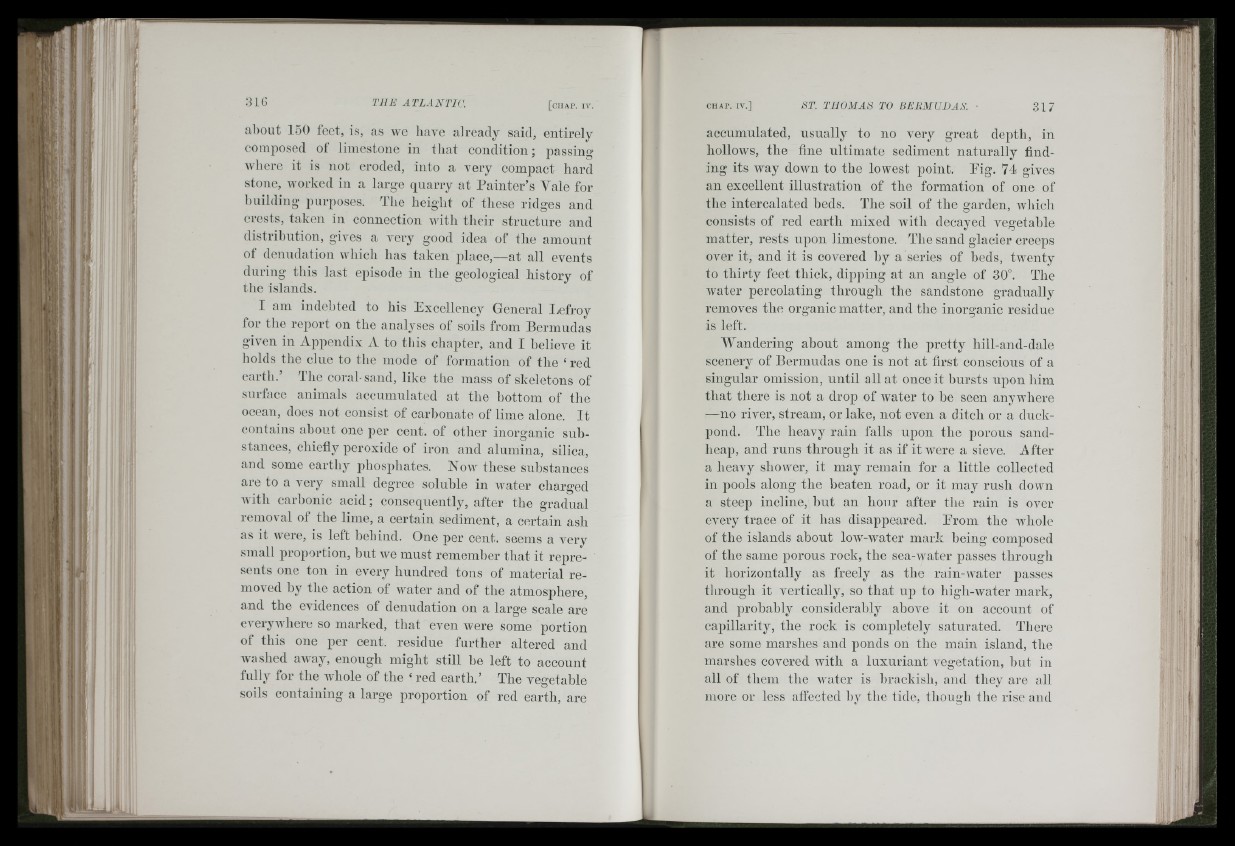
t n
-■1
aliout 150 loet, is, as we ]ia\'e already said, entirely
eoiniiosed of limestone in tliat condition; pas
CE
Avdiere it is not eroded, into a very compact hard
stone, Avorked in a large quarry at Painter’s Vale for
Imilding purposes. The heiglit of these ridges and
crests, taken in connection Avith their structure and
distribution, gives a very good idea of the amount
of denudation Avbicb bas taken place,—at all events
during tbis last episode in tbe geological history of
tbe islands.
I am indebted to bis Excellency General læfroy
for tbe rejiort on the analyses of soils from Bermudas
given in Appendix A to this chapter, and I believe it
bolds tbe clue to tbe mode of formation of the ‘ red
earth.’ The coral-sand, like the mass of skeletons of
surface animals accumulated at the hottom of tlie
ocean, does not consist of carbonate of lime alone. It
contains about one ]ier cent, of other inorganic substances,
chiefly peroxide of iron and alumina, silica,
aud some earthy phosphates. N o a v these substances
are to a very small degree soluble in Avater charged
Avith carhonic acid; consequently, after the gradual
removal of the lime, a certain sediment, a certain ash
as it were, is left behind. One per cent, seems a very
small proportion, but Ave must remember that it represents
one ton in every hundred tons of material removed
by tbe action of water and of the atmosphere,
and tbe evidences of denudation on a large scale are
everyAvbere so marked, that even were some portion
of tbis one per cent, residue furtber altered and
Avaslied aAvay, enough might still he left to account
fully for the Avhole of the ‘ red earth.’ The vegetable
soils containing a large proportion of red earth, are
accumulated, usually to no very great depth, in
holloAVS, the fine ultimate sediment naturally finding
its way doAA'n to tbe lowest point. Eig. 74 gives
an excellent illustration of tbe formation of one of
tbe intercalated beds. The soil of tbe garden, which
consists of red earth mixed with decayed vegetable
matter, rests upon limestone. Tbe sand glacier creeps
over it, and it is covered by a series of beds, tAventy
to thirty feet thick, dipping at an angle of 30°. Tbe
Avater percolating through the sandstone gradually
removes the organic matter, and the inorganic residue
is left.
Wandering ahout among the pretty hill-and-dale
scenery of Bermudas one is not at first conscious of a
singular omission, until all at once it bursts upon him
tbat there is not a drop of Avater to be seen anyAvhere
—no river, stream, or lake, not even a ditch or a duek-
pond. The heavy rain falls upon the porous sand-
heap, and runs through it as if it Avere a sieve. After
a heavy shower, it may remain for a little collected
in pools along the beaten road, or it may rush down
a steep incline, but an hour after tiie rain is over
every trace of it has disappeared. Erom the Avhole
of the islands about loAV-water mark heing composed
of the same porous rock, the sea-Avater passes through
it horizontally as freely as the rain-Avater passes
through it A'ertically, so that up to high-Avater mark,
and probably considerably above it on account of
capillarity, the rock is completely saturated. There
are some marshes and ponds on the main island, the
marshes covered Avith a luxuriant vegetation, hut in
all of tliem the Avater is lirackish, aud they are all
more or less affected liy the tide, tliough the rise aud
. I I
ii'iil?
|.